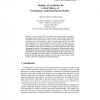Free Online Productivity Tools
i2Speak
i2Symbol
i2OCR
iTex2Img
iWeb2Print
iWeb2Shot
i2Type
iPdf2Split
iPdf2Merge
i2Bopomofo
i2Arabic
i2Style
i2Image
i2PDF
iLatex2Rtf
Sci2ools
AE
2005
Springer
2005
Springer
Outlines of Artificial Life: A Brief History of Evolutionary Individual Based Models
In the research field of Artificial Life, the concepts of emergence and adaptation form the basis of a class of models which describes reproducing individuals whose characteristics evolve over time. These models allow to investigate the laws of evolution, to observe emergent phenomena at individual and population level, and additionally yield new design techniques for computer animation and robotics industries. This paper presents an introductory non-exhaustive survey of the constitutive work of the last twenty years. When examining the history of development of these models, different periods can be distinguished. Each one incorporated new modeling concepts, however to this day all the models have failed to exhibit long-lasting, let alone open-ended evolution. A particular look at the richness of dynamics of the modeled environments reveals that only little attention has been paid to their design, which could account for the experienced evolutionary barrier.
| Added | 26 Jun 2010 |
| Updated | 26 Jun 2010 |
| Type | Conference |
| Year | 2005 |
| Where | AE |
| Authors | Stefan Bornhofen, Claude Lattaud |
Comments (0)

